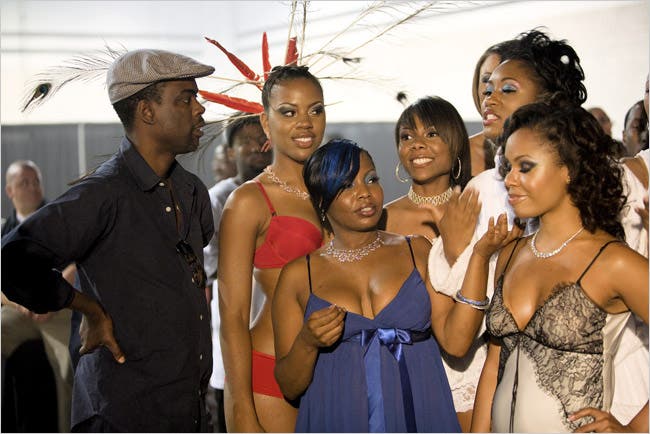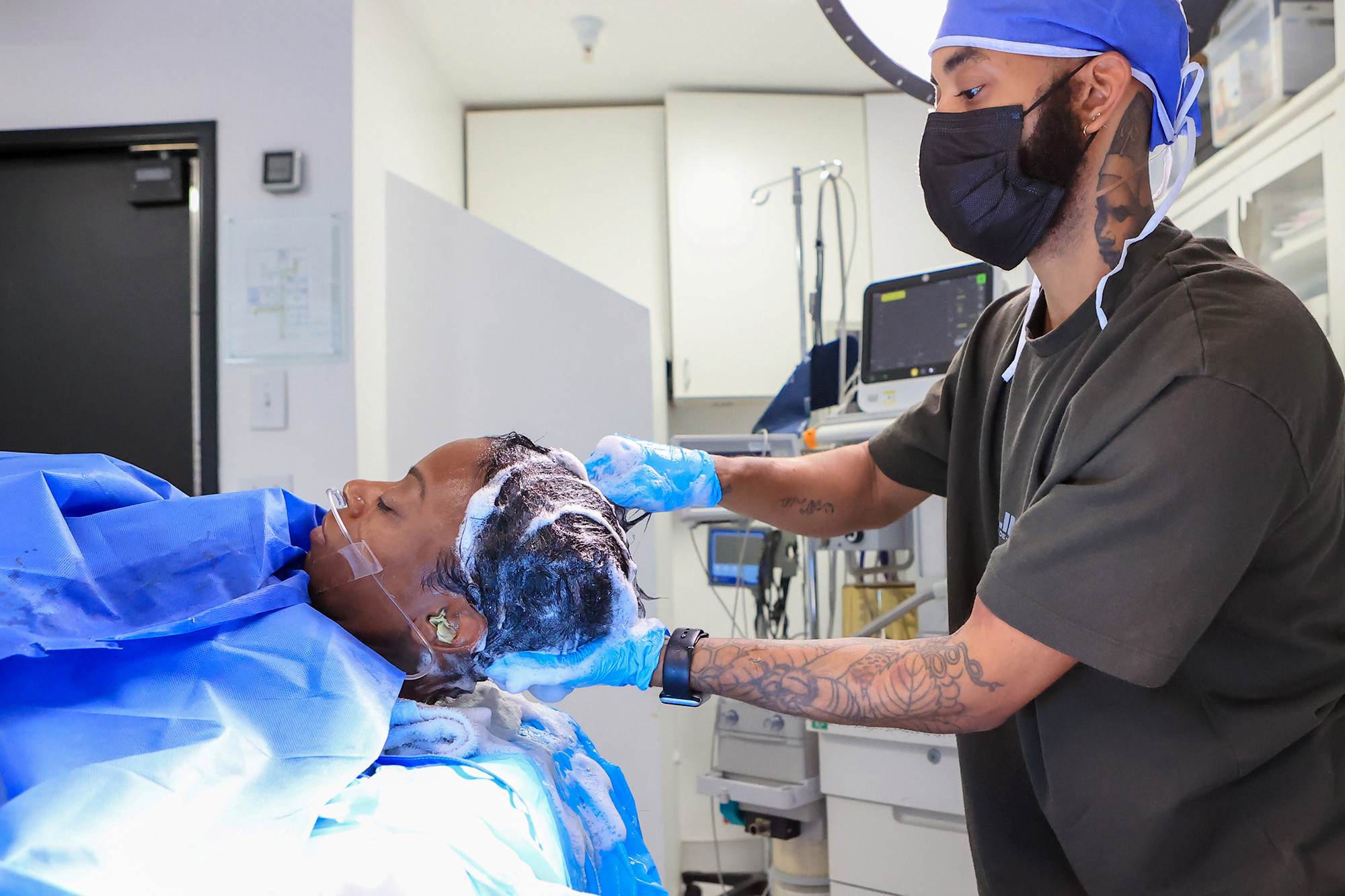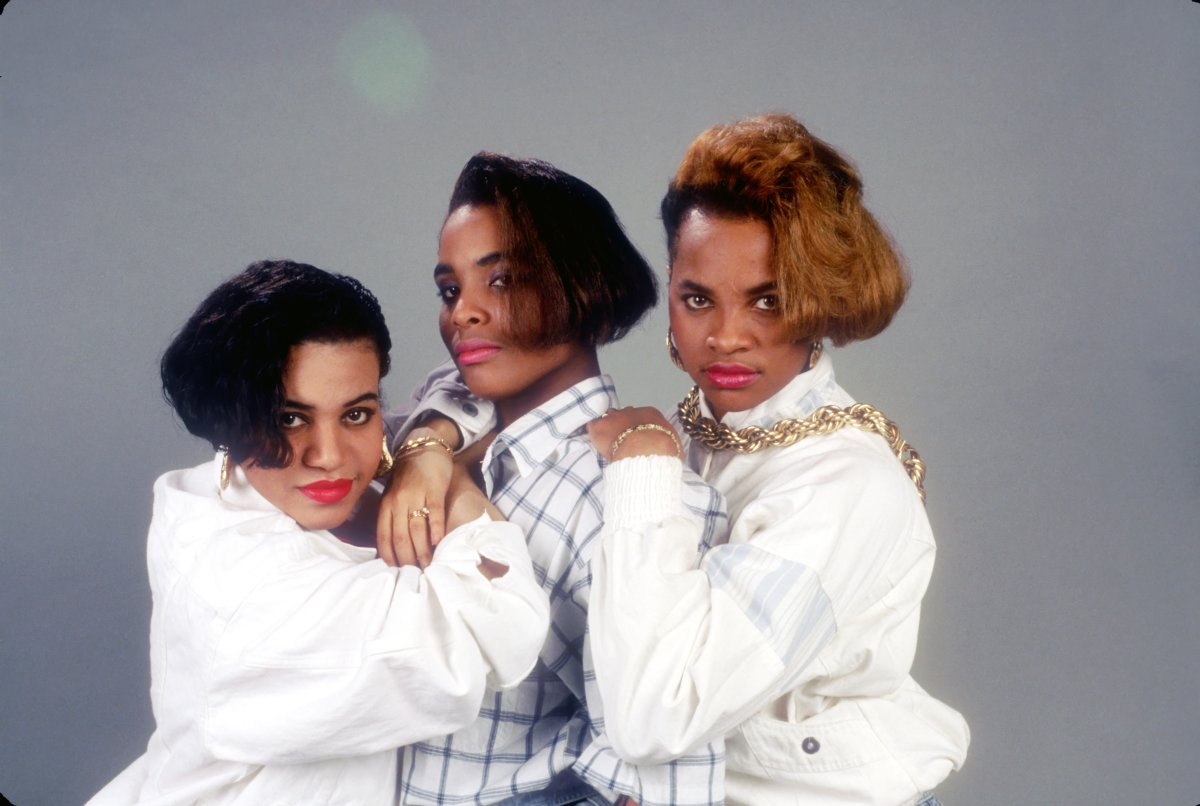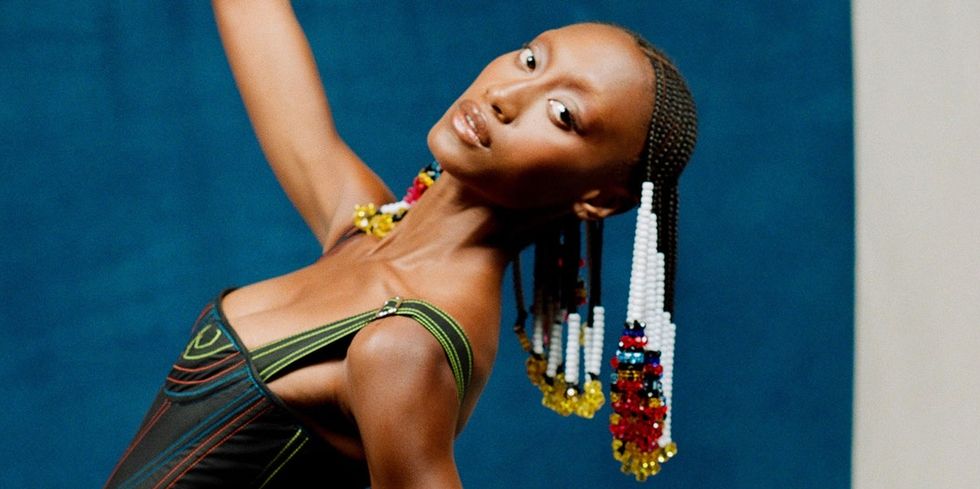It’s almost impossible to be a beautiful Black girl. A Black Lady Sketch Show playfully addresses the herculean task of Black girl beauty in the sketch, ‘Bad Bitch Support Group’. In this sketch Angela Bassett, Robin Thede, Laverne Cox, Amara La Negra and Gabrielle Dennis are a group of bad bitches who come together, in their lace-fronts and large earrings, false eyelashes and sequined tops, sharp cheek contours and high heeled shoes to discuss the burdens of achieving desirability Alcohol-Anonymous style. Maya (Dennis) bravely shares, “Well, sometimes I wish that I was not a bad bitch all the time, like sometimes I wish that I was just an OK bitch,” to the absolute shock and horror of her fellow attendees.
“It’s just a lot of pressure,” she continues.

She’s frustrated over always having to be so done-up, wearing 3 inch heels as house slippers, constricted breathing from waist trainers and she expresses envy from seeing a woman walking down the street without lashes and seemingly content with being just OK. It’s a funny skit about about impossible beauty standards and how women tend to internalise all this labour as an honour and a badge of pride. It’s big business to make sure that women not only think they have to put in all this work every day to be considered beautiful, but they should also feel like it’s their imperative and for their benefit.
But for Black women, beauty isn’t a choice. Especially when it comes to the political battleground that is our hair. The feminine beauty standard is thin, white, cis and able-bodied. And for every box you fail to check on that list, the more society will punish you. And while it might cause business to suffer great costs if Black women reject these standards (Black hair care and products in Africa alone are valued at over $6 billion), it costs Black women even more to comply with or reject these standards.
The business of Black hair is incredibly expensive.

This goes for naturals and women who partake in extensions, wigs and protective styles. High quality human hair lace wigs can go for upwards of R2k, natural haircare products have been found to cost 9 times more than ‘regular’ products and most protective styling, an essential to maintaining and protecting Black hair, often requires professional labour. This is especially startling when you remember that Black women are also the lowest earning demographic.
And most Black women, very aware of this tab, often do their own hair. We often remark at how magnificent Black women are for equipping themselves with the Loreal professional skills that allow them to turn onion ponytails into long kanekalon braids, the hours they put into wash days and twist-outs, or how a lot of women wake up at the crack of dawn to ensure their lace wigs are applied so well it looks like their scalps. But I find very little to celebrate in how much money and/or time Black women have to clock in, day in and day out, to meet beauty ideals. Especially since we’re often also contributing the most unpaid labour in our households and workplaces – should we be so fortunate to get a job in this economy.

And it’s not simply that Black women can just reject all of this either – as the perception of natural hair as ‘unkempt’ or ‘unprofessional’ can deny you a job or a normal education, and being beautiful can provide the required media attention and urgency when you’re the victim of gender based violence. For Black women, complying to beauty standards is the only way to gain any semblance of dignity and humanity.
Beyond the time and money we spend, there are still (still) more costs.
“Black girls are trained early in beauty salons to smell smoke on themselves but to never yell ‘fire.’” – Dara Mathis
In ‘Shedding the Shame of a Black Girl’s Broken Edges’, Dara Mathis mentions that Black girls will “accept a level of pain as par for the course during beautification”. It’s how we’ve all sat through chemical relaxers that were burning our scalps because that’s simply the process, or how we all regularly accept that trying to sleep is agonising for the first days of braids and even why it was so unsurprising that Gorilla Glue Gate ever happened. We come to understand all of this without feeling the need to pass any moral judgement on Tessica Brown, who recently went viral for using Gorilla Glue as hairspray after running out of Got2B Glue. For over a month after, Brown’s hair was glued to her scalp by the industrial strength glue to such an extent that it required medical treatment to remove.

Brown quickly became the talk of the internet for 3 weeks straight. At best, she was the butt of “strong as gorilla glue” jokes and, at worst, she became an avenue for violent misogynoir. Whether or not you think it was just a foolish error, it did remind me of how often Black women, and women in general, are constantly using thrifty and sometimes very dangerous products to achieve beauty – such as weave glue for false eyelashes or plumping your lips with a shot glass. Yet, Brown ended up being compared to a ‘gorilla’, the subject of a Saturday Night Live skit and receiving death threats for her mistake. The pain in Black beauty doesn’t end just at the physical implications; our attempts are also perfect fodder for comedians and entertainers who delight in our suffering. There’s a sense that it’s also humorous to the rest of the world that Black women would even attempt to be beautiful, or that our attempts will always fall short and that is amusing. Why else would it be so funny and trendy for people to rip off our wigs in public for TikTok pranks? Or referring to our short updos as struggle or onion ponytails in memes? And if we’re not being mocked, then we’re being patronised, pitied and shamed.
I remember Chris Rock’s ‘Good Hair’ documentary as being something of a cultural reset. Suddenly, after years of indifference or ignorance, everyone had something to say about the sad state of Black girl hair. We all wanted to be white, we all hated ourselves, and we were all prepared to die in salon chairs if it meant we could straighten all of these kinks. Never mind that women of all races chemically process their hair in some way, or get extensions, there was just something so pathetic about the way we did it. It wasn’t all bad – the documentary was a first of its kind, sparking several unprecedented conversations about Black hair and haircare. A few years later, the natural hair movement would pick up steam. It’s so much easier today to have the option to be natural or choose extensions or have a relaxer and be catered for in the media and the shopping aisle.

Though it’s also important to mention that the natural hair community – the seemingly welcoming movement all about self-acceptance and health over beauty – also perpetuates unattainable ideals too. In the ‘90s, Andre Walker originated the curl pattern system that most of the natural hair community lives by today in order to categorise natural hair by its look and needs. Type 1 hair is straight, Type 2 is wavy, Type 3 is curly and Type 4, which most Black women fall under, is kinky-coily. These types are further broken down into subcategories, such as Type 3C which is a corkscrew like curl or Type 4B which is a tight coil in a Z-shaped pattern.
Texturism describes the way in which hair with looser, finer curls, such as Type 3 to Type 4A, are favoured or praised over tighter, denser curls (4B and 4C). Generally, but not always, women with these looser, finer curls are often mixed-race or biracial Black women which adds another dimension of colourism. It can be decided that once again, the closer your natural hair is to whiteness, the more acceptable it is.

Which has led to a rise in Black women with dense coils drowning their hair in moisturisers and conditioners in order to loosen their curl patterns and fit into this more palatable idea of natural hair. Or be deceived by hair stylists and YouTubers with looser curls pretending that they have 4C curls, just like you, which can be made to look like 3C curls with just enough product and work. It’s especially insidious that even within a movement where Black women are supposed to finally let their hair be, they’re still expected to perform all this manipulation and spend all that money to be beautiful.
The ugly business of beauty
As a billion dollar industry, it will come as no surprise that there are also several environmental and labour implications to Black hair and hair care. The biggest portion of that industry is the ‘dry hair market’: wigs, extensions and braiding hair.
Human hair extensions are the most expensive – they’re favoured for their real look, status and how they can be manipulated with heat and chemical products. The majority of human hair is sourced from South East Asia and in places like India, women donate their hair during religious rites which are then auctioned off to be processed into lace fronts and clip-ins. More conscious companies might ensure that their hair is ethically sourced, from willing participants who receive fair compensation for their hair. More often than not, however, many poor Southeast Asian women are exploited for their hair with some receiving less than $3 (R45) for their hair, which is then flipped into a luxury status symbol for women in the West, who can spend upwards of $500 for that same hair. In some countries like Venezuela, Vietnam and the Ukraine, women are held at knife or gunpoint for their hair. The industry as a whole is incredibly unregulated, and the common practice of industrialists targeting poor, vulnerable women in often wartorn or poverty stricken countries, to obtain their hair for cheap goes unchecked. This also limits the consumer’s ability to trace where their hair comes from to ensure that it was sourced ethically if they wanted to.

Choosing synthetic hair, whether for the more accessible cost, it’s malleability or for ethical reasons, isn’t a better solution either. Synthetic hair fibre is made from acrylic, polyester or polyvinyl which are all plastic fibers. Plastic fibers require fossil fuels like petroleum to be constructed and as well as dangerous, hazardous chemicals. They’re also non-biodegradable and very difficult to recycle which contributes to further pollution as synthetic hair is consumed and disposed of in the same, unsustainable manner as fast fashion. Moreover, a lot of hair is treated with carcinogenic, toxic chemicals that are harmful to both factory workers and end consumers. Human hair isn’t very biodegradable either and while there is a growth of hair recycling and waste management initiatives, it’s not a commonly known issue and it’s far from being very effective.
The sum total

Black hair is complex and overwhelming. There are so many social, economic, environmental and political implications in the high demands of beauty standards and it will take more than just Black girl magic or demystifying natural hair to upend that. I’ve often been one to ask that Black hair decisions needn’t be so political – can I not like my hair today without it being a reflection of internalised racism? Can I wear a blonde wig without it being a radical expression of self-love? However, when adding up all the costs of Black girl beauty, for all the lives and livelihoods affected; for the crushed self-esteems and bolstered self-images; it’s always going to mean something. I just want it to mean something good moving forward.
As Sydney (La Negra) in Bad Bitch Support Group laments, “We didn’t choose this life. This life chose us.”



















































